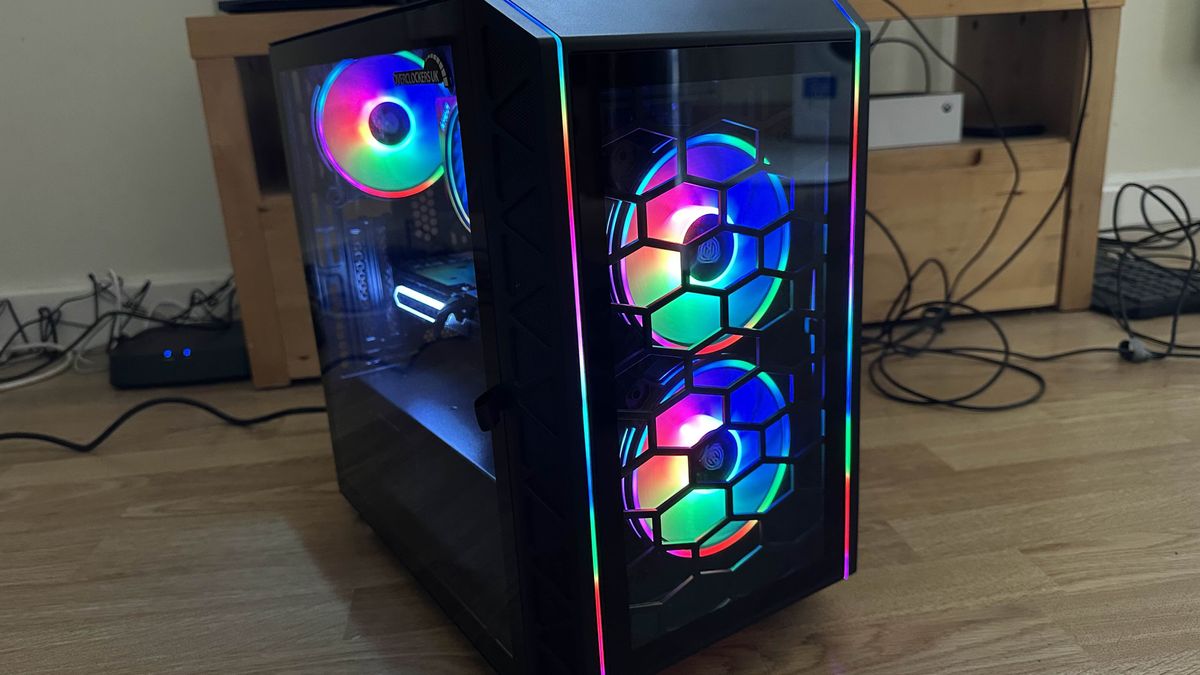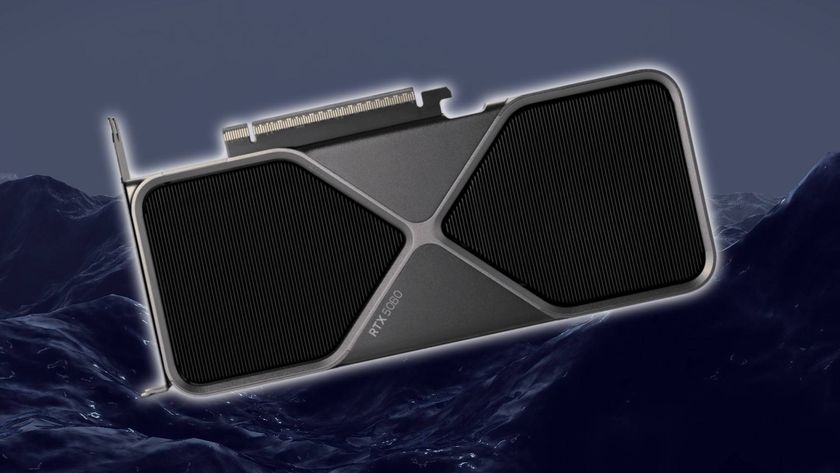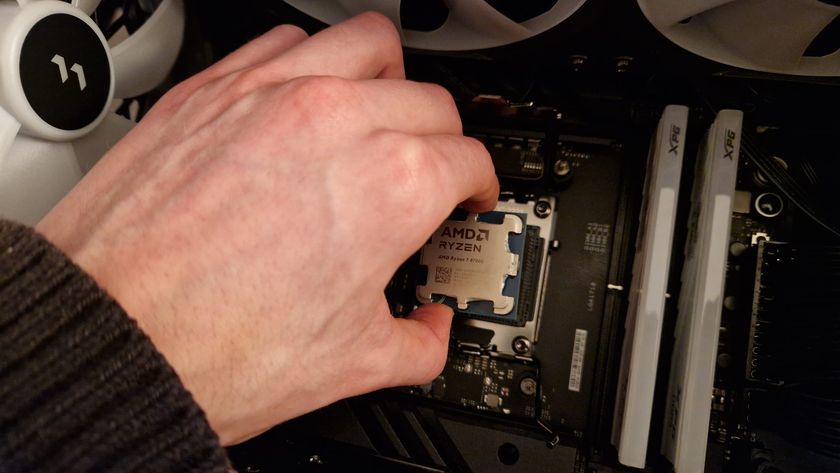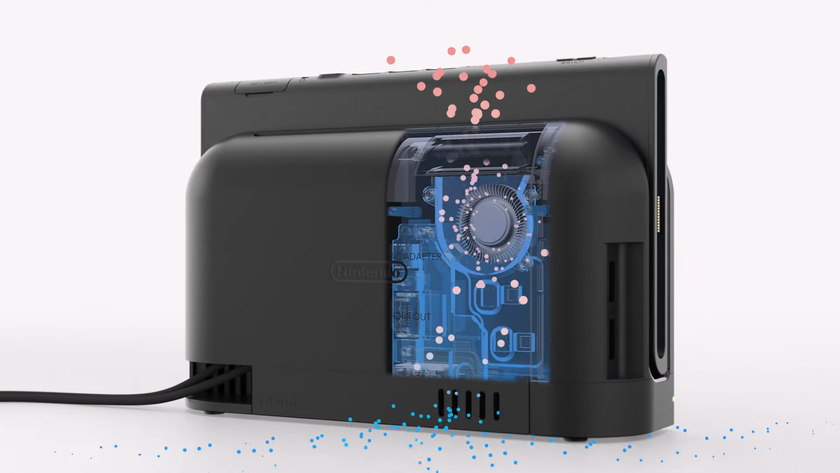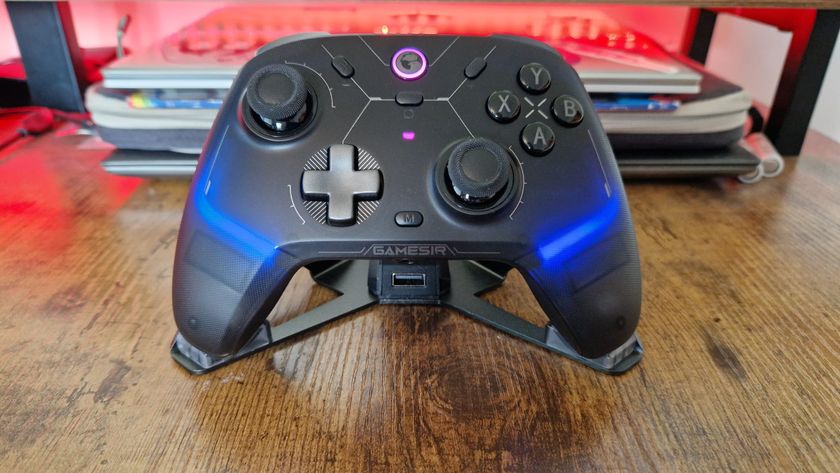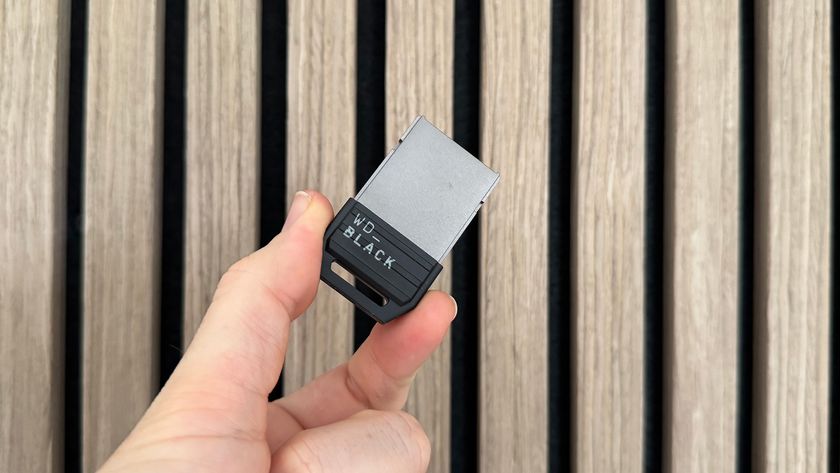12DOVE Verdict
The Refract Jade Gaming PC is an impressive entry-level rig for gamers who want to experience what PC gaming has to offer while not breaking the bank. However, at over double the price of a PS5 Pro is it worth the money?
Pros
- +
Simple to set up and use
- +
Impressive 1080p and 1440p performance
- +
Great entry-level gaming PC
- +
Tasteful and customisable RGB
- +
Room to upgrade individual parts in the future
Cons
- -
Can get very loud during gameplay (1440p and 4K)
- -
Runs very hot in certain games
- -
Slow SSD
Why you can trust 12DOVE
Look, I’m going to be honest. I am someone who has put off PC gaming for a long time based purely on convenience and price. But it’s hard to deny with the cost of console gaming ever increasing, (looking at you, PS5 Pro) PC gaming is getting more and more attractive. And that’s where the Overclockers Refract Gaming Jade PC comes in.
Hitting the market at £1,499 (often discounted to £1,399) and targeting high frame-rate 1080p/1440p gaming, it certainly makes a compelling argument as to why you might become part of the “PC master race.” Rocking an Nvidia GeForce RTX 4060 Ti GPU and 32GB of DDR5 RAM, it certainly will hold its own against some of the best gaming PCs in the UK.
But is it good enough that you’ll finally make the jump from console gaming, ditch that PS5 or Xbox Series X|S and pick up a mouse and keyboard? Surprisingly for me, it might be.
Refract Gaming Jade: Specs
I was immediately interested in the Refract Jade PC when I was approached to review it. It featured some impressive specs for a PC that positions it firmly in the 1080p/1440p range, with some allowance for 4K too. For years I’ve been used to gaming on console, or on my severely underpowered PC from 10 years ago - more on that later. I was excited to get my hands on a rig with an RTX 4060 Ti so that I could really push my PC gaming to places it’s never been before.
Overall, the Refract Jade has a pretty appealing configuration without breaking the bank. Granted, building a PC yourself, particularly during the Winter deals season, can sometimes work out cheaper. With the impending RTX 50 series from Nvidia, there is no doubt the prices will drop on this GPU, so you may even find this rig cheaper as time moves on. Here are the specs:
| Price | £1,499.99 |
| CPU | AMD Ryzen 7 7700 |
| GPU | Nvidia GeForce RTX 4060 Ti |
| RAM | 32GB DDR5 (5600MHz) AMD EXPO Dual-Channel Kit |
| Storage | 1TB M.2 SSD |
| Motherboard | AMD B650 WiFi DDR5 Micro-ATX Motherboard |
| PSU | 600W 80 Plus Gold Power Supply |
Design
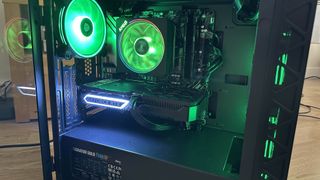
Convenience. That’s one of the key reasons I’ve refrained from PC gaming for such a long time. Who wants to have a huge, bulky unit next to their TV when playing games on their TV, after all? So when I saw how relatively compact the Refract Gaming Jade PC was, it got me excited. While it’s not the smallest gaming PC case you can get, its Micro ATX size fits perfectly next to my entertainment unit in the living room and incredibly well next to my desk. It might not be quite as compact as the Acer Predator Orion X, but it won’t take up all the real estate you have in a gaming room.
Inside the Kolink Citadel Glass case, I am once again impressed with how much space each component has to breathe inside. You are able to gain easy access to the inside of the PC via a very handy glass panel that simply swings open. After having to unscrew the side panel of my previous PC every time I needed to clean inside or change a component, this was a lovely revelation.
I’ve always found myself hesitant to jump into PC gaming... Jumping forward 10 years to 2024 and getting my hands on the Refract Jade PC leaves me with one question: what was 15-year-old me thinking? PC gaming is great.
Along the front of the device, you have your obligatory RGB which comes with a remote control to allow you to tinker with and tweak the lights display to your heart's delight. If anyone knows me they will know I’m not the biggest fan of unnecessary RGB but I wasn’t offended by it here. However, being able to fully control the colour of it both for the case and its internal components was kinda fun, and being able to turn it off fully on the fly was a big win in my book.
Along the top of the chassis, you’ll have access to 2x USB 3.0 ports and a single USB Type-C. I’d have liked an additional USB-C port at the front of the PC as more and more of my peripherals are going that way. However, just around the corner at the rear, you’ll find a couple more USB ports including a second USB-C, multiple USB-A, and the usual HDMI port on the motherboard. Meanwhile, you’ll find an additional HDMI 2.1 port, which I would recommend using, alongside three DisplayPort 2.1 slots.
The design is super simple, which is kind of what you’d expect for a mid-range pre-built gaming PC but that doesn’t mean it is a bad thing. It looks smart, premium, and low-profile all at the same time - RGB aside.
Performance
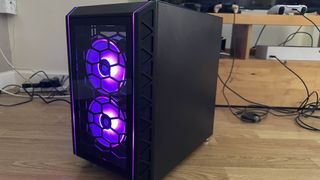
As I’ve said, I’ve always found myself hesitant to jump into PC gaming. I have, for years, preferred the comfort of coming home, turning on my PS5, and sinking into the couch. That’s not to say that I never tried. I bought my first ever gaming PC back in 2014 and I loved it but admittedly it soon became an afterthought once it started to struggle with games. I even tried plugging it into my TV for that big screen, console-like experience but it was a behemoth and it wasn’t as appealing as my PS4 Pro. Jumping forward 10 years to 2024 and getting my hands on the Refract Jade PC leaves me with one question: what was 15-year-old me thinking? PC gaming is great.
Booting up this PC for the first time I had this inclination to continue where I left off 10 years ago with a little game called Watch_Dogs - a title I have also been revisiting lately via GeForce Now. Except this time I decided to install a few graphics mods to push it to the limit. I was amazed to see it look exactly how I remember the E3 2012 trailer looking, something you’ll never experience on a console. It was at this point I started to think ‘Hey, maybe this PC gaming thing is pretty good.’
Throughout my time with the Refract Gaming Jade PC, I have used it for work, streaming, and a little light video editing. Overall, I’ve fully incorporated it into my daily life. I never encountered any issues while using it for all my daily needs as it whizzed through every task I threw at it - without the fluff of proprietary software that can ruin the user experience of some prebuilt PCs. The only hiccup I ever experienced in my time with the PC during day-to-day use was not being able to connect to wi-fi which was solved via a quick reboot. This was in the first two days of using the PC and it never happened again.
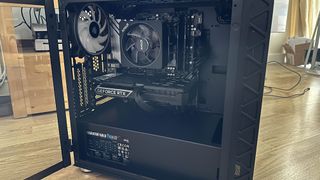
When it comes to gaming, I want to say that this was an absolute delight but there were a few big instances that made me question that. One of the games I decided to play was The Last of Us Part 1, one of my favourite games on PlayStation, and unfortunately, the experience was rough. Numerous times while running in 1440p the game would crash, freeze, or just refuse to open. Granted, after speaking with GamesRadar’s resident Hardware Editor Duncan Robertson, he reminded me that the game has experienced some technical difficulties on PC so it’s hard to tell if it was a dodgy port or the machine.
These issues did extend to my time playing Dying Light 2: Beyond Human - I swear I didn’t just play post-apocalyptic games for this review - as I experienced on three occasions the game crashing while in both 1440p and 1080p resolution settings. This primarily came during night-time sequences in-game and when there were numerous enemies on screen.
Cinebench:
Multi Core: 1036pts
Single Core: 1115pts
3DMark:
Timespy: 13,348
Firestrike: 31,500
Steel Nomad: 2,840
CrystalDiskMark:
Sequential Read: 5,227MB/s
Sequential Write: 4,823MB/s
CPU-Z RAM timings:
36-38-38-80
That said, outside of those two games I didn’t encounter many issues while playing games and my experience was smooth for the most part. In fact, I was surprised at just how well it performed both in day-to-day gaming and in benchmarking technical tests. The Nvidia GeForce RTX 4060 Ti is a genuinely impressive GPU, especially considering it is targeting mid-range performance. I often found that the performance pushed well past mid-range and hit much higher levels than you’d expect from a more expensive PC.
I was also particularly impressed by how fast this gaming PC was throughout my time with it. In daily use, it performed impressively quickly and flew through any and all tasks including video editing and After Effects rendering and exporting - something which even my work PC normally struggles with.
Speaking of benchmarking, I tested this PC using our tried and tested, industry-standard software which gave me a good idea of how the Refract Gaming Jade PC performs under stress. As you can see below via the benchmarking results across multiple games, the Refract Jade performs exceptionally well across the majority of tests, particularly when set to 1440p.
While it is clear from the results that it’s capable of 4K gaming, especially when using DLSS if you’re ray-tracing, you’re going to see the best performance if you choose to play in 1440p (or 1080p if you don’t have one of the best gaming monitors to support higher resolutions). What really stood out to me was how well it handled Hitman: World of Assassination - one of my most played games on PS5 - and Shadow of the Tomb Raider. Both games I have played extensively on console, so I had high expectations when moving over to PC. Jumping into Hitman’s Dubai level I was blown away at the ray-tracing reflections on windows, the smooth marble floors, and Agent 47’s bald head - okay, maybe not that last one. While that game already looks good on PS5, it’s hard to deny that the graphical fidelity here is better than what I have been playing with for the past three years.
Outside of the games we typically use for benchmarking thanks to their in-game settings, I decided to continue my Xbox Series S playthrough of Star Wars Outlaws. I was expecting a 2024 release to perhaps make the PC struggle a little more, but I was pleased to say that it was a very smooth experience while playing at 1440p with ray-tracing and DLSS enabled. A much better experience than what I had on my Xbox Series S.
Jumping into Hitman’s Dubai level I was blown away at the ray-tracing reflections on windows, the smooth marble floors, and Agent 47’s bald head - okay, maybe not that last one.
While the actual gameplay may have been smooth, the PC sounded like it was experiencing turbulence at 42,000 feet during a hurricane. This was often when I pushed the PC to its limits with 4K gaming with ray-tracing enabled, but I can’t honestly say that it didn’t sound like it was going to take off when playing games in 1440p. 1080p was a different matter as it stayed relatively silent save for a few small instances, but they were very rare. However, as long as you have one of the best computer speakers on the market, you can just turn that volume right up and you’ll soon not notice it. Since the machine is air-cooled only, you're always going to run the risk of noise pollution.
This extends to temperature too. I did notice the PC outputting a large amount of heat while gaming in 4K or 1440p, something which I fully expected but it did get concerning at times. As someone who usually games on consoles that remain silent and fairly cool, it did get concerning at how much hot air was being pushed out of the case - then again, it’s gonna be winter soon so maybe this will save money when you don’t have to put the central heating on. As an example, during 3DMark's Fire Strike test, the GPU and CPU reached peak temperatures of 82 degrees Celsius and 68 degrees Celsius respectively. In Time Spy, they peaked at 73 and 70 degrees Celsius, and they leveled out at 70 and 50 degrees Celsius in Steel Nomad.
Should you buy the Refract Gaming Jade PC?
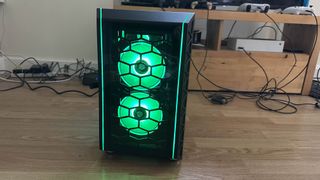
Personally, I think it’s tough to deny that the Refract Gaming Jade PC is a quality product that is worth looking at if you’re wanting to dive into PC gaming. With impressive performance across 1080p and 1440p gaming, alongside a good effort at 4K gaming all for £1,499 you’re getting a pretty damn good gaming PC, one that challenges some of the best PCs from other brands.
Where I find this hard to recommend is to gamers who are jumping into this world from console gaming. While you’re getting better performance in the majority of games on Xbox Series X|S and PlayStation 5 by comparison, you’re also spending over £1000 more for that pleasure. But if you’ve been tempted by the idea of the upcoming PS5 Pro, then maybe you are better off stretching a little bit and going for the Refract Jade as it does more than just video games, giving you more bang for your buck and an easy way to future proof yourself and keep upgrading your rig.
It’s a particularly good offering for those who just want to plug their PC in and get straight into the games. There is no nonsense here as it’s entirely built for you and you don’t have to stress about getting the right parts, often the part of the PC gaming that turns people away. So if you have the cash to spare but don’t want the hassle, then the Refract Gaming Jade PC is as good a machine as any to finally join the PC realm.
How we tested the Refract Jade Gaming PC
I used the Refract Jade Gaming PC as my main daily use PC at home for three weeks, this included editing video, working in Photoshop, and of course, gaming. I used it as my primary source of gaming throughout those three weeks by using both my 1080p PC monitor and my 4K TV in my living room.
To benchmark the PC I tested our go-to games, alongside Cinebench, CrystalDiskMark, CPU-Z, and 3DMark.
For more on how we test gaming PCs here at 12DOVE, have a read of our full hardware policy.
For more PC coverage, check out the best CPUs for gaming, the best RAM for gaming, and the best computer speakers.
For as long as I can remember, I've had a fascination with video games and technology. From a young age, I was always reading up on the latest tech and begging my parents to buy it for me - now I have my own job and make my own money, I realize why they often had to say no to my requests. For that reason, I love trying to find the best value gear so I can recommend it when asked. I studied Journalism at Edinburgh Napier University and throughout my time there gaming was one of my main focuses. Alongside Duncan Robertson, I was the co-host of NerdCulture, a weekly gaming and nerdy news radio show. My time as Studio Manager for the uni radio station meant tinkering with a lot of technology to ensure each broadcast worked smoothly. Elsewhere, you can find me discussing professional wrestling as Cultaholic's Community and Social Media Manager, and you'll also see me on the occasional Twitch stream.
